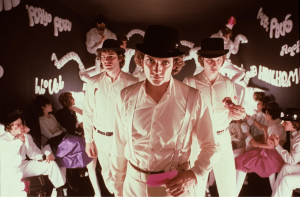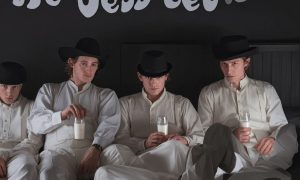𝗔 𝗖𝗹𝗼𝗰𝗸𝘄𝗼𝗿𝗸 𝗢𝗿𝗮𝗻𝗴𝗲 (1971), directed by Stanley Kubrick and based on the novel by Anthony Burgess, is a provocative and dystopian film that explores themes of free will, violence, and social control. Set in a bleak, futuristic society, the film follows Alex DeLarge (Malcolm McDowell), a teenage delinquent and leader of a gang of “droogs” who engage in brutal acts of violence, including assault, theft, and rape, for sport.

The film opens with Alex and his gang committing a series of violent crimes, enjoying a hedonistic lifestyle in which they control their environment through fear and dominance. However, after a violent robbery goes wrong, Alex is betrayed by his gang and sent to prison. While incarcerated, Alex volunteers to undergo a controversial new experimental treatment called Ludovico’s Technique, which is designed to condition him into a state of behavioral “reform” by making him violently ill at the mere thought of violence.

The treatment effectively strips Alex of his ability to choose between good and evil, rendering him incapable of defending himself or making independent decisions. This “clockwork” process turns Alex into a passive, docile figure, unable to resist external influence. After being released from prison, Alex finds himself a victim of the violence he once inflicted, unable to escape the oppressive system that has broken him down.

As the film progresses, Alex struggles to reclaim his autonomy and humanity in a world that seeks to control and reshape him. The film ends with a controversial and open-ended conclusion, as Alex begins to fantasize about a future where he can regain his freedom and live on his own terms.
A Clockwork Orange is known for its disturbing imagery, satirical commentary on authoritarianism and the consequences of social control, and its exploration of the tension between free will and societal influence. The film remains a polarizing and influential work in cinematic history, known for its unsettling portrayal of violence, youth culture, and the dehumanizing effects of state-sponsored rehabilitation.
